
Imagine you’re trying to select the right hinge for a new door installation or repair project. Each type of hinge has its unique look and purpose, much like different shoe styles for various occasions. Choosing the wrong one can lead to frustration, not to mention a door that just doesn’t fit right. In this guide, we’ll break down the differences between butt, mortise, and non-mortise hinges, helping you find the best option for your needs.
What is a Butt Hinge?
A butt hinge is one of the most common types you’ll encounter. It’s typically made of two rectangular metal plates (called leaves) that are joined by a pin. Think of it like a couple dancing together—moving in sync while still allowing for individual motion. When mounted, the leaves are attached to the door and the door frame, letting the door swing smoothly.
Identifying Butt Hinges is easy. Look for these key characteristics:
- Two rectangular leaves
- Simple design with no additional cutouts
- Commonly used for interior doors
Honestly, butt hinges can be found in a variety of sizes and finishes, making them versatile for all sorts of doors. They’re usually surface-mounted, meaning they sit on the edges of the door and frame, providing a strong yet unobtrusive support.
What is a Mortise Hinge?
Now, let’s move on to mortise hinges. These are a bit more specialized and can add a touch of elegance and functionality. Imagine a fitting puzzle piece; a mortise hinge is designed to fit into a pocket (or mortise) cut into the edge of the door and its frame. This recessed design allows the door to sit flush with the frame when closed, giving a cleaner look.
To identify a mortise hinge, look for:
- A rectangular cutout for the hinge to fit into
- Usually larger and sturdier than butt hinges
- Often used for heavier doors like entryways or commercial doors
Here’s the thing: mortise hinges provide better support for heavier doors and can also enhance security. Since they fit into the door, they’re less likely to be tampered with, making them a great choice for external doors.
What is a Non-Mortise Hinge?
Next up is the non-mortise hinge, which is essentially a compromise between butt and mortise hinges. These are surface-mounted like butt hinges but designed to allow for a bit more depth at the edges of the door, making them easier to install. Imagine non-mortise hinges as the friendly middle child of door hinges, blending the properties of the other two types.
A few things to notice about non-mortise hinges:
- They have a hinge knuckle that extends outwards
- Often used for lighter doors
- Easier and quicker to install than mortise hinges
Non-mortise hinges are great for DIY projects, especially if you’re not keen on complicated installations. Plus, their design allows for minor adjustments, making them quite handy if your door alignment needs a tweak.
Comparing the Three Types of Hinges
Now that you know what each type of hinge is, you might wonder which one is best for your door. Let’s break it down a bit more.
Butt hinges are perfect for most interior doors, especially if you want something simple and reliable. They’re widely available and come in various finishes.
Moving on to mortise hinges, they shine when it comes to durability. If you have a heavy door or need something that provides extra security, these are the way to go. But keep in mind, they require precise installation and cutting into the door frame.
On the other hand, non-mortise hinges are about ease and convenience. If you’re tackling a DIY project and want straightforward installation without the need for extensive woodworking skills, these hinges should be your go-to.
Installation Tips for Each Hinge Type
Installing hinges might seem tricky, but with the right tips, you can make it a breeze. For butt hinges, start by marking the screw locations, ensuring they line up correctly with the door and frame. Use a drill to create pilot holes, which will prevent wood from splitting.
For mortise hinges, the installation requires a bit more precision. You need to measure and cut the mortise into the door and frame, ensuring the hinge fits snugly. A chisel is usually necessary for this process. Don’t rush this step; a good fit means smoother operation.
When it comes to non-mortise hinges, the key is to line them up perfectly for easy installation. Position them on the edge and press firmly before drilling. Because they sit on the surface, adjustments are often easier if things aren’t lining up perfectly, so keep that in mind.
When to Choose Each Type of Hinge?
Knowing when to choose each hinge type can save you time and frustration. Start with butt hinges for general use. They’re a classic choice for most interior doors and are budget-friendly.
Choose mortise hinges when dealing with heavy or high-traffic doors. Their design can withstand wear and tear better, which is crucial for entry doors that often see a lot of use.
Opt for non-mortise hinges if you want a quick, no-fuss installation. They can work well for lightweight doors and are ideal for projects where speed is essential.
Understanding how to identify different door hinge types, like butt, mortise, and non-mortise, can make a significant difference in your door installation or repair project. Each type has its strengths and specific applications, so being informed will lead to better choices.
Remember, it’s all about the right fit for your needs—just like finding the perfect outfit. So, whether you aim for the simplicity of butt hinges, the durability of mortise hinges, or the ease of non-mortise hinges, you’re now equipped to make an informed decision. Happy installing!
